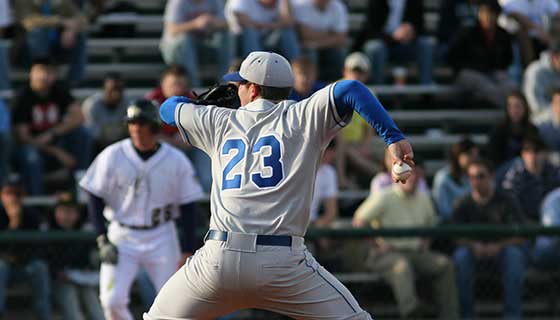Elbow Problems in Little League Baseball Players
What You Need to Know
- Because pitchers throw hard and often, they are most at risk for elbow and shoulder problems associated with throwing.
- Stress from throwing is absorbed in the cartilage at the ends of the bones in young baseball players where growth plates are located.
- Signs of damage include pain when throwing, pain after throwing, swelling around the elbow and loss of motion.
What kinds of orthopaedic problems do children have with throwing a baseball?
Throwing a baseball can put tremendous amounts of stress upon the throwing arm of both adults and younger baseball players. In adults, the stress is absorbed by the ligaments and tendons and as a result they tend to get tendinitis or stretching of the ligaments. However, in growing children, the stress is absorbed by the weakest parts of the bones, which are the cartilage at the ends of the bones. This cartilage is the part of the bone where growth occurs, and damage to this area can have long-term consequences for the shoulder or elbow.
Repetitive throwing places severe stress on the elbow joint. The throwing motion stretches the tendons and ligaments on the inner side of the elbow and compresses the structures on the outer side. These forces can damage tissue and bone, especially in young athletes whose bones have not fully matured.
What is the growth plate?
The growth plate is a specialized part of the bone located near the joint which is where growing of the bones occurs. This area is not as strong as the bone, ligaments or tendons. As a result, when the shoulder or elbow feels the stress of a baseball pitch, the growth plate is affected by this stress more than the other structures. This is only a problem if the stress occurs too frequently and if the stress is large. Players who pitch are at risk the most for these problems because they throw hard and often. This is one of the reasons that the number of innings (and hopefully the number of pitches) allowed by a player are limited by league rules.
What happens when there is too much stress on the growth plate?
The cartilage of the growth plate cannot tolerate excessive stress, and the first sign it is being overworked is pain. Pain in the elbow or shoulder of a growing baseball player is not normal and should not be hidden with ice or medication. If the damage continues after the onset of pain, then the growth plate actually can break.
In the elbow this is usually on the inside of the elbow, and a small piece of the bone where the tendons attach can actually pull off. If severe, this may need surgery to replace the bone. In the elbow, the cartilage of the joint can actually be damaged as well. If this occurs the elbow may lose the cartilage in the joint on the ends of the bones, which is called arthritis. Damage to the cartilage in the joint of a young baseball player can result in damage of the joint function for the rest of their lives.
In the shoulder, the growth plate can fracture and cause significant time away from the sport. Rarely the upper arm bone may break if it sees too much stress over time. For these reasons, pain in the shoulder, arm or elbow should not be ignored in a young baseball player.
5 Tips for Preventing Sports-Related Injuries

Many sports injuries result from pushing our bodies past our current physical limits or level of conditioning.
Follow these five tips from sports medicine expert Dr. Andrew Cosgarea to avoid getting hurt.What are the signs of this damage to the arm and how is it detected?
The earliest sign is pain with throwing, and as the damage progresses the pain can continue after throwing. If the damage becomes worse there may be swelling around the elbow and even loss of motion. In the shoulder the only symptom is pain, and swelling is rarely seen. The pain is usually made worse only by throwing and not by other activities.
An evaluation by a physician will help confirm the diagnosis. Radiographs, or plain X-rays, will sometimes confirm the diagnosis. On the X-ray, the growth plate damage may show up as widening of the growth plate or damage to the joint. If the X-rays are normal then it may be necessary to do other studies, such as a bone scan or a magnetic resonance imaging (MRI) scan. These tests may show subtle damage not visible on regular X-rays.
How can these conditions be prevented?
Because these problems are due to the stress of throwing a baseball, these conditions may be preventable by limiting the number of times the athlete throws. The guides provided by most leagues are designed to prevent throwing too many pitches or too many innings. However, many players throw at practice or at home on their own. Unfortunately there are probably no definite number of pitches that determine when damage occurs. For this reason it is important that the player be honest about having pain and the adults involved inquire frequently about any discomfort reported by the player. It is important not to try to hide the pain or ignore its presence.






